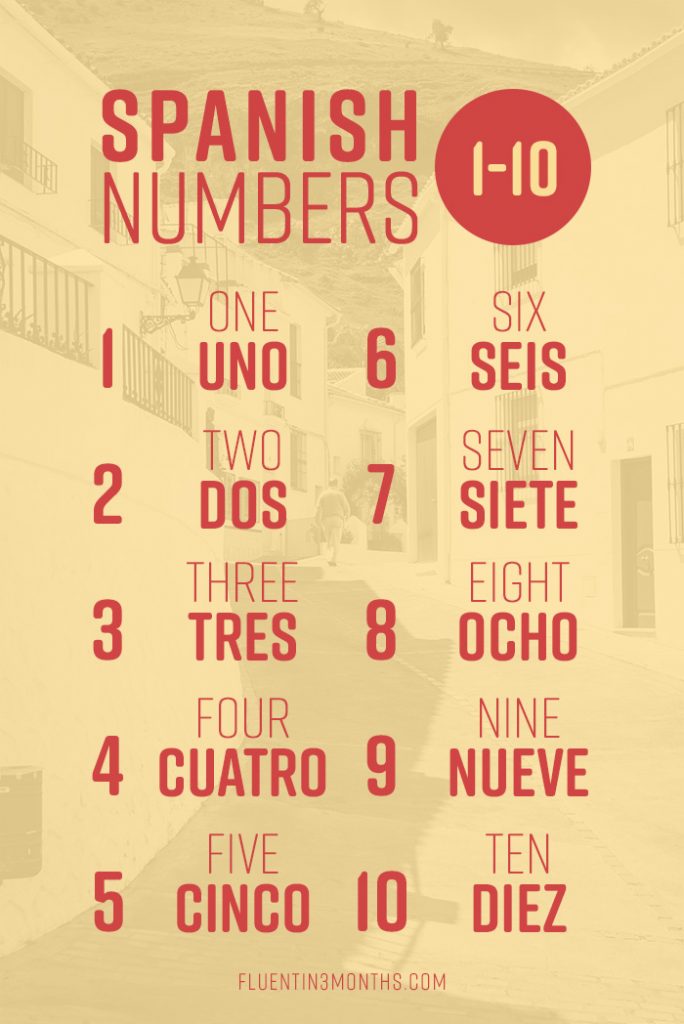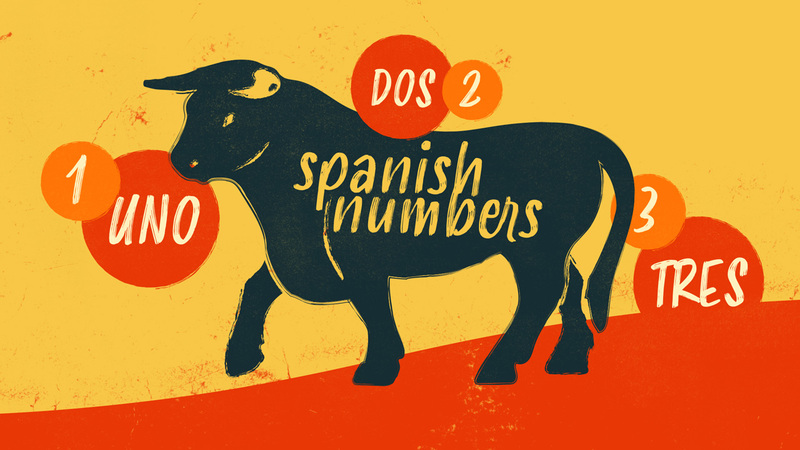Spanish Numbers: How to Count from 1 – 1,000+ in Spanish
Would you like to know about Spanish numbers, and how to count from 1-100 in Spanish?
In this article, I share everything you need to know about numbers in Spanish. I cover what the Spanish numbers are, examples of how to use them, and so much more.
- Spanish for Numbers 1-10
- 1 – 100 Spanish Numbers
- Counting Spanish Numbers 1 – 1000+
- Billions and Trillions in Spanish (They’re Not What You Think)
- How Do You Pronounce Spanish Numbers?
- Spanish for “One”: Un, Uno, or Una?
- Spanish for 100: Cien or Ciento?
- Breaking Up Spanish Numbers: Dots or Commas?
- How to Say “…and a Half” in Spanish
- Ordinal Numbers in Spanish
- Examples of How to Use Spanish Numbers
- Numbers in Spanish: How Do You Learn Them?
In case you were wondering how to say “numbers” in Spanish, it’s números. The word for “number” in Spanish is número.
So, let's learn some números, starting with Spanish cardinal numbers!

Before we get into the article, if you are interested in learning Spanish yourself, you should know that I’ve created a bunch of digital products to help with many aspects of language learning, and run a coaching program (Bootcamp) that has had many Spanish learners take part and successfully speak the language after 3 intensive months.
If you’ve tried and failed to learn Spanish in the past, I wrote an entire book that you can download called “Why Spanish is Easy” to help encourage those who need a new perspective on the language.
Or maybe you can already speak a little, but you’re stuck in “Intermediate hell” with your Spanish? I’ve a video course specifically on how to escape that and move towards mastery! Or, if you just want a single casual summary of everything you need to know for getting started, check out our “Dabble Spanish” video lecture!
For the first time ever, I’m running a 50% off sale on absolutely everything offered on the site (plus $100 off Bootcamp). Just use the discount code “SUMMER” at checkout. Check out the full list here!
Spanish for Numbers 1-10
Let's start with the basics. Here are the cardinal numbers in Spanish from 1-10:
1 – uno
2 – dos
3 – tres
4 – cuatro
5 – cinco
6 – seis
7 – siete
8 – ocho
9 – nueve
10 – diez

1 – 100 Spanish Numbers
Now for the Spanish numbers 1 to 100. After you've read these, I'll explain some tricks for remembering them.
| 1 uno | 2 dos | 3 tres | 4 cuatro | 5 cinco |
| 6 seis | 7 siete | 8 ocho | 9 nueve | 10 diez |
| 11 once | 12 doce | 13 trece | 14 catorce | 15 quince |
| 16 dieciséis | 17 diecisiete | 18 dieciocho | 19 diecinueve | 20 veinte |
| 21 veintiuno | 22 veintidós | 23 veintitrés | 24 veinticuatro | 25 veinticinco |
| 26 veintiséis | 27 veintisiete | 28 veintiocho | 29 veintinueve | 30 treinta |
| 31 treinta y uno | 32 treinta y dos | 33 treinta y tres | 34 treinta y cuatro | 35 treinta y cinco |
| 36 treinta y seis | 37 treinta y siete | 38 treinta y ocho | 39 treinta y nueve | 40 cuarenta |
| 41 cuarenta y uno | 42 cuarenta y dos | 43 cuarenta y tres | 44 cuarenta y cuatro | 45 cuarenta y cinco |
| 46 cuarenta y seis | 47 cuarenta y siete | 48 cuarenta y ocho | 49 cuarenta y nueve | 50 cincuenta |
| 51 cincuenta y uno | 52 cincuenta y dos | 53 cincuenta y tres | 54 cincuenta y cuatro | 55 cincuenta y cinco |
| 56 cincuenta y seis | 57 cincuenta y siete | 58 cincuenta y ocho | 59 cincuenta y nueve | 60 sesenta |
| 61 sesenta y uno | 62 sesenta y dos | 63 sesenta y tres | 64 sesenta y cuatro | 65 sesenta y cinco |
| 66 sesenta y seis | 67 sesenta y siete | 68 sesenta y ocho | 69 sesenta y nueve | 70 setenta |
| 71 setenta y uno | 72 setenta y dos | 73 setenta y tres | 74 setenta y cuatro | 75 setenta y cinco |
| 76 setenta y seis | 77 setenta y siete | 78 setenta y ocho | 79 setenta y nueve | 80 ochenta |
| 81 ochenta y uno | 82 ochenta y dos | 83 ochenta y tres | 84 ochenta y cuatro | 85 ochenta y cinco |
| 86 ochenta y seis | 87 ochenta y siete | 88 ochenta y ocho | 89 ochenta y nueve | 90 noventa |
| 91 noventa y uno | 92 noventa y dos | 93 noventa y tres | 94 noventa y cuatro | 95 noventa y cinco |
| 96 noventa y seis | 97 noventa y siete | 98 noventa y ocho | 99 noventa y nueve | 100 cien |
Take a look and try to spot the patterns. I recommend you follow these steps to get all the numbers into your head:
- Learn the numbers for 1-15. There's no real pattern, you just have to learn them: uno, dos, tres, cuatro, cinco, seis, siete, ocho, nueve, diez, once, doce, trece, catorce, quince.
- Learn the numbers for the multiples of ten: veinte, treinta, cuarenta, cincuenta, sesenta, setenta, ochenta, noventa. A few tips to help you remember:
• Other than veinte, they all end in -enta
• Other than veinte (again), they all have a clear relationship with the related smaller number: cuatro <-> cuarenta, ocho <-> ochenta, etc.
Then, you can fill in the gaps with a simple formula:
- For numbers from 16-19, take the rightmost digit and say “diez + y + (digit)”. E.g. 17 = “diez + y + siete” = “diez y siete”, which contracts to diecisiete. This is much like how in English 16 is “six-ten” i.e. “sixteen”.
- For numbers above twenty, simply take the “tens” number (veinte, treinta, etc.) and the “ones” number (uno, dos, etc.) and stick y (“and”) in the middle. E.g. 31 = “thirty and one” = treinta y uno.
- The only extra thing to be aware of is that numbers from 21-29 get contracted into a single word – so instead of “veinte y cuatro”, it's “veinticuatro”.
Finally, don’t forget:
- zero – cero (this one should be easy to remember!)
- 100 – cien (note the link with English words like “century” or “percent“.)
Want to learn Spanish fast? Then check out our favourite Spanish course, SpanishPod101. It includes fun, easy to follow lessons on Spanish numbers.
Counting Spanish Numbers 1 – 1000+
For numbers from 100 to 199, use ciento:
- 101 – ciento uno
- 129 – ciento veintinueve
- 195 – ciento noventa y cinco
(Note that you don't need to add y after ciento – it's ciento uno, not ciento y uno.)
For numbers from 200 to 999, you must first learn the multiples of 100.
- 200 – doscientos
- 300 – trescientos
- 400 – cuatrocientos
- 500 – quinientos
- 600 – seiscientos
- 700 – setecientos
- 800 – ochocientos
- 900 – novecientos
These numbers have masculine and feminine forms, and so they must agree with the noun:
- setecientas personas – “seven hundred people”
- ochocientos libros = “eight hundred books”
The only two new words you need to learn are mil (1,000) and un millón (1,000,000).
Note: 1,000 is mil, not un mil. For un millón, you can't leave out the un.
The only time you'll see un mil is in numbers like cuarenta y un mil (41,000). You need to put an un in this number to distinguish it from cuarenta mil (40,000).
Forming new numbers with mil and un millón is pretty straightforward as well:
- 1,000 – mil
- 1,001 – mil uno (not “mil y uno”!)
- 1,686 – mil seiscientos ochenta y seis
- 2,001 – dos mil uno
- 20,000 – veinte mil
- 100,000 – cien mil
- 483,382 – cuatrocientos ochenta y tres mil trescientos ochenta y dos
- 1,000,000 – un millón
- 6,492,000 – seis millones cuatrocientos noventa y dos mil
Finally, note that when you're using un millón or millones with a noun, you must use de. For example, “one million books” is un millón de libros. Literally, “one million of books”.
Billions and Trillions in Spanish (They’re Not What You Think)
What do you think the Spanish words billón and trillón mean? Did you guess “billion” and “trillion”? Sadly, things aren't that simple.
In the English-speaking world, a “billion” is one thousand millions (1,000,000,000) and a “trillion” is one thousand billions (1,000,000,000,000). In other words, every “step up” involves multiplying by 1,000.
Not everyone does it like this! Our way is called the “short scale” numbering system. But many countries around the world – including most Spanish-speaking countries – use the “long scale” system.
In this system, a “billion” is one million millions, and a “trillion” is one million billions. Rather than multiplying by a thousand each time, you multiply by a million.
So Spanish words like billón don't “match up” with their English counterparts like you might expect:
- un millón – one million = 1,000,000
- un millardo (or “mil millones”) – one billion = 1,000,000,000
- un billón – one trillion = 1,000,000,000,000
- mil billones – one quadrillion = 1,000,000,000,000,000
- un trillón – one quintillion = 1,000,000,000,000,000,000
(By the way, in the past, American English used the short-scale system while British English used the long-scale system. This is no longer true – all dialects of English now use the short-scale system.)
How Do You Pronounce Spanish Numbers?
So how do you say Spanish numbers? If you have trouble pronouncing the words, then take a listen to this video:
Spanish for “One”: Un, Uno, or Una?
Spanish doesn't distinguish between “one” and “a” in the same way that English does. Un libro can mean “a book” or “one book”.
When you think about it, those two phrases mean the same thing; the only difference is in emphasis.
But the word uno changes to match the gender of the noun it describes. Before a feminine noun, it becomes una. Before a masculine noun, you drop the o and just use un.
Some examples:
- Un libro – “a book/one book”. Drop the “o” from uno because it's followed by a masculine noun.
- Una mesa – “a table/one table”. Change uno to una because it's followed by a feminine noun.
- Tengo uno – “I have one”. Uno is unchanged because it's not followed by a noun.
- “¿Hay preguntas?” “Solo una.” – “Any questions?” “Only one”. In this case, you use una because you're referring to a pregunta (“question”), which is a feminine word.
Spanish for 100: Cien or Ciento?
The number 100 can be translated into Spanish as either cien or ciento. What's the difference?
You should use cien when you have exactly one hundred of something:
- Cien personas – one hundred people
- Cien libros – one hundred books
Use ciento as part of a larger number, like ciento uno for “one hundred and one”.

Breaking Up Spanish Numbers: Dots or Commas?
In English, it's conventional to break up big numbers with a comma every three digits to aid readability. So instead of writing “1048710123901”, we write “1,048,710,123,901”.
We also mark the decimal point with a dot, so “one half” is “0.5”.
Be careful! In Spanish-speaking countries – as in many other parts of the world – these conventions are reversed. They use a comma for decimals and break up large numbers with dots. Or, they put a space between every three digits.
So my two examples above would be written as “1.048.710.123.901” (or “1 048 710 123 901”) and “0,5”.
How to Say “…and a Half” in Spanish
In English, we often abbreviate the names of numbers by saying “… and a half”, “… and a third”, and so on.
So instead of saying “two thousand five hundred”, an English speaker might say “two and a half thousand”. Instead of “one million five hundred thousand”, they might say “one and a half million”.
I often notice Spanish people getting this wrong when they speak English. They put the “and a half” in the wrong place – instead of saying (for example) “one and a half million”, they say “one million and a half”. That's because they're translating directly from how they'd say in Spanish – un millón y medio.
Try not to make the opposite mistake when you speak Spanish. Say un millón y medio, not un y medio millón.
Ordinal Numbers in Spanish
So far I’ve only talked about cardinal numbers – one, two, three, etc. You also need to learn the ordinal numbers – first, second, third, fourth, etc.
Here are the first ten:
| English | Español |
|---|---|
| first | primero |
| second | segundo |
| third | tercero |
| fourth | cuarto |
| fifth | quinto |
| sixth | sexto |
| seventh | séptimo |
| eighth | octavo |
| ninth | noveno |
| tenth | décimo |
Ordinal numbers are adjectives that must agree with the noun. But unlike most Spanish adjectives, they go before the noun, not after:
- el segundo libro – “the second book”
- las primeras flores – “the first flowers”
Note that primero and tercero drop the “o” before a singular masculine noun:
- el primer día – “the first day”
- el tercer hijo – “the third son”
To form ordinal numbers above 10, you must learn the numbers for the multiples of ten:
| English | Español |
|---|---|
| twentieth | vigésimo |
| thirtieth | trigésimo |
| fortieth | cuadragésimo |
| fiftieth | quincuagésimo |
| sixtieth | sexagésimo |
| seventieth | septuagésimo |
| eightieth | octogésimo |
| ninetieth | nonagésimo |
Then fill in the gaps by combining numbers from the above two tables, such as vigésimo segundo for “22nd”.
Remember that both parts of the number must agree with the noun: “the 22nd person” would be la vigésima segunda persona.
For numbers from “11th” to “19th”, it’s more common to write them as one word than two. Such as decimoprimero for “11th”.
Examples of How to Use Spanish Numbers
You’ve learned the numbers, but how do you use them? After all, there are many instances where we use numbers everyday. Things like time, the date, our age, etc.
So here are some examples to help you get started:
Time:
- 1:10 – la una y diez
- 3:25 – las tres vienticinco
Date:
- September 10 – el diez de septiembre
- January 1 – el primero de enero
Age:
- 10 years old – (tener) diez años
- 37 years old – (tener) treinta y siete
As Adjectives:
- Two books – dos libros
- 300 flowers – trescientas flores
Prices:
- $2.20 – dos [dólares] con veinte [centavos]
- $15.50 – quince [dólares] con cincuenta [centavos]
Math:
- 3 + 3 = 6 – tres más tres son seis
- 10 – 2 = 8 – diez menos dos son ocho

Numbers in Spanish: How Do You Learn Them?
Here’s a funny story about Spanish numbers:
In 2008 the American football player Chad Johnson legally changed his last name to “Ochocinco”. This new moniker was a reference to his jersey number: 85. The problem – as you’ll now know – is that ocho-cinco doesn't mean “eighty-five”. The correct Spanish is ochenta y cinco. It's unknown whether Chad was aware of this mistake when he made the name change. (In 2012, he changed his last name back to “Johnson”.)
Now you’ve read this article, you’re not going to make a mistake like that.
Next, you can learn the 101 core Spanish words to start speaking fast. Or spice up your Spanish with synonyms.




Social